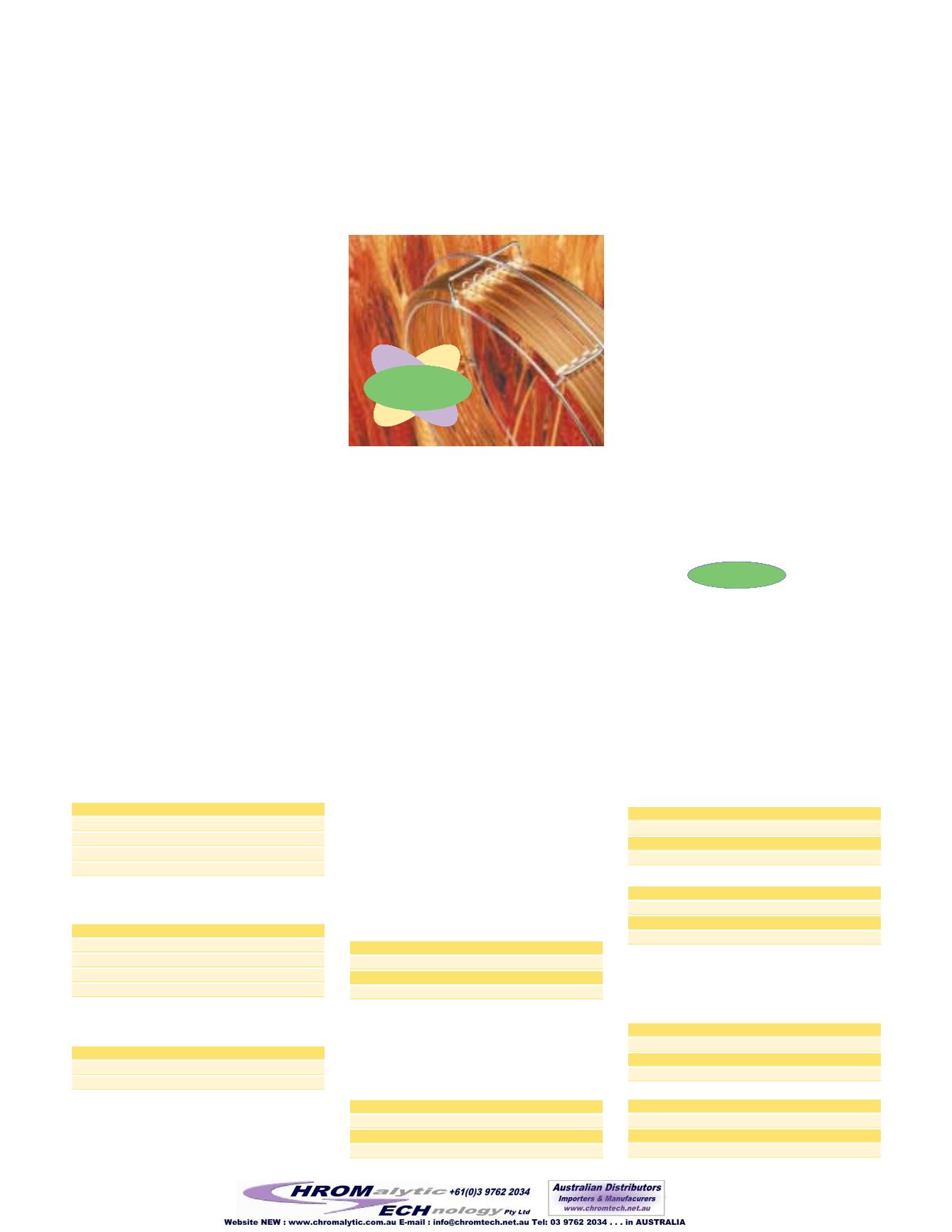

• 14 •
www.restekcorp.comRtx
®
-OPPesticides2
GC Column for the Analysis of
Organophosphorous Pesticides
by Frank Dorman, Ph.D., Environmental Innovations Team Chemist
Several years ago Restek introduced the
Rtx
®
-OPPesticides column, which was the first
column designed specifically for the analysis of
organophosphorus pesticides according to US
Environmental Protection Agency (EPA) Method
8140. While this column was clearly superior to
any other commercially available stationary phase
for this separation, the need for confirmational
analysis still made the choice of column pair
unclear.
The Rtx
®
-OPPesticides column was designed using
early versions of computer modeling techniques
and, since then, column requirements have changed
as the EPA has added more target compounds.
1
EPA
Method 8141A now requires 53 compounds to be
completely resolved using a two-column system.
Additionally, for laboratories preferring to use gas
chromatography/mass spectrometry (GC/MS) for
this analysis, it is important to have no coelution
between compounds with similar mass spectra.
To address these requirements, Restek developed a
new column using a more sophisticated modeling
technique (i.e., a computer program helps deter-
mine optimum phase structure and column dimen-
sions based on the specific separation require-
ments). This new Rtx
®
-OPPesticides2 column has a
330°C maximum operating temperature, low bleed,
and excellent inertness. It completely separates all
of the target compounds in US EPA Method 8141A
when used in combination with the Rtx
®
-
OPPesticides column (Figure 1). This analysis
results in only two coelutions on the Rtx
®
-
OPPesticides2 column: thionazin and tributyl phos-
phate, and parathion-ethyl and trichloronate.
However, these compounds do not coelute on the
Rtx
®
-OPPesticides column, so a complete separa-
✔
Rtx
®
-OPPesticides Columns
Temp limits: -20 to 310/330°C
ID (mm) df (µm)
20-Meter
30-Meter
0.18
0.25
56898
—
0.25
0.40
— 55239
0.32
0.50
— 11239
0.53
0.83
— 11240
✔
Rtx
®
-OPPesticides2 Columns
Temp limits: -20 to 310/330°C
ID (mm) df (µm)
20-Meter
30-Meter
0.18
0.20
11244
—
0.25
0.25
— 11243
0.32
0.32
— 11241
0.53
0.50
— 11242
✔
“Y” Press-Tight
®
Connectors
Type
ea.
3-pk.
straight
20405
20406
angled
20403
20404
tion is attainable using the column pair.
When using a nitrogen phosphorus detector (NPD)
or a flame photometric detector (FPD), the
0.32mm ID Rtx
®
-OPPesticides and Rtx
®
-
OPPesticides2 column pair is optimal; use direct
injection via a single injection port and split the
sample into the two columns with a glass 'Y'
PressTight
®
connector. For GC/MS analysis, the
Rtx
®
-OPPesticides2 column can be used alone
because the two coelutions have dissimilar mass
spectra, so different quantitation ions can be used
to resolve them.
In summary, the Rtx
®
-OPPesticides and Rtx
®
-
OPPesticides2 column pair is ideal for the analysis
of organophosphate pesticides. These columns
were designed using computer-modeling techniques
to be superior to any other commercially available
stationary phases for this separation. If you are
involved in the separation of organophosphate pes-
ticides and would like more information, please
contact the Restek Technical Service Team at
814-353-1300 or 800-356-1688, ext. 4.
References
1. Frank L. Dorman, Paul D. Schettler, Christopher M. English, and
Michael J. Feeney, LC GC, 18 (9), 928-934, 2000.
References not available from Restek.
for
more
info
Request the
Rtx
®
-OPPesticides2 Column
brochure (lit. cat.# 59275).
new
✔
No coelutions between
compounds with similar mass
spectra—column can be used
alone with MS
✔
Confirmational column for
Rtx
®
-OPPesticides
✔
8140/8141 OP Pesticide Calibration
Mix A
azinphos methyl
fenthion
bolstar (sulprofos)
merphos
chlorpyrifos
methyl parathion
coumaphos
mevinphos
demeton, O and S
naled
diazinon
phorate
dichlorvos
ronnel
disulfoton
stirofos
ethoprop
tokuthion (prothiofos)
fensulfothion
trichloronate
200µg/mL each in hexane/acetone (95%/5%), 1mL/ampul
Ea.
5-pk.
10-pk.
32277
32277-510
—
with data pack
32277-500
32277-520
32377
✔
8141 OP Pesticide Calibration Mix B
dimethoate
parathion
EPN
sulfotepp
malathion
TEPP
monocrotophos
200µg/mL each in hexane/acetone (95%/5%), 1mL/ampul
Ea.
5-pk.
10-pk.
32278
32278-510
—
with data pack
32278-500
32278-520
32378
✔
Method 8140/8141 Internal
Standards & Surrogates
1,000µg/mL each in acetone, 1mL/ampul
NPD Detector
Internal Standard:
1-bromo-2-nitrobenzene
Surrogate:
4-chloro-3-nitrobenzotrifluoride
1-bromo-2-nitrobenzene Standard
Ea.
5-pk.
10-pk.
32279
32279-510
—
with data pack
32279-500
32279-520
32379
4-chloro-3-nitrobenzotrifluoride Standard
Ea.
5-pk.
10-pk.
32282
32282-510
—
with data pack
32282-500
32282-520
32382
FPD Detector
Internal Standard:
none recommended
Surrogate:
tributylphosphate and triphenylphosphate
Tributylphosphate Standard
Ea.
5-pk.
10-pk.
32280
32280-510
—
with data pack
32280-500
32280-520
32380
Triphenylphosphate Standard
Ea.
5-pk.
10-pk.
32281
32281-510
—
with data pack
32281-500
32281-520
32381


















